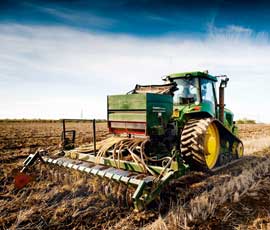New advice for winter bean drilling rates

New grower guidance on recommended plant populations for individual winter bean varieties has been issued just ahead of drilling.
It follows the results from plant population trials conducted by pulse specialists Wherry & Sons, which have shown that higher yields are achieved as plant density increases.
In 2012, a positive yield response to an increase in plant density was recorded by the company at its trial site in Cambridgeshire, when five winter bean varieties were sown at different three-plant densities (18cm, 12cm and 8.5cm apart in the row, with a row width of 30cm).
In all cases, the highest yields came from greatest density, with the shortest-strawed varieties giving the largest responses as density increased.
As a result, recommended plant populations for the company’s winter bean varieties had been revised for this autumn and were now between 22 and 36 plants established, which allowed for the tillering capacity of individual varieties, explained Peter Smith, crops director at Wherry & Sons.
“Based on this trial, the ideal plant population for winter beans would seem to be between 46 and 52 stems/sq m,” he reported.
As some varieties don’t tiller as readily as others, adjustments have to be made accordingly, he said. “Honey and Sultan are two good examples of this. They are the shortest varieties and they benefit from higher stem numbers, towards 55-60 stems/sq m.”
Sultan also had a low thousand grain weight, or small seed size, so showed a better response with an increase in stem numbers, he added.
Clipper, Arthur and Wizard produce higher tiller numbers, so their target was for 45-50 stems/sq m, continued Mr Smith.
“These are higher plant numbers than some growers are used to,” he acknowledged. “But the old figure of 18 plants established comes from work done a long time ago and is not as relevant to the shorter, stiffer varieties that are grown now.
“There is a height increase as density increases, but this didn’t translate into lodging this season with the newer types, despite the crops being quite tall.”
This year, growers should check both the germination and the TGW before considering seed-bed conditions, he said.
“These new recommendations are based on a single year, but they do bear out what growers have been telling us. It’s worth remembering that in a very cold winter, tillering may be more exaggerated.”
Higher seed rates and earlier sowing dates paid off in NIAB TAG winter bean work across all varieties in 2012, said Simon Kightley, who stressed that the technique appears to be best suited to the newer, shorter varieties.
“It’s not suitable for taller beans. And there can be weed control issues from early sowing dates,” he said. Wherry & Son’s trials are set to continue in 2013.
Optibean project looks at bean agronomy
Winter bean agronomy is being re-examined in TSB’s collaborative £2m Optibean project, confirmed PGRO, with plant populations coming under scrutiny.
First-year results were only just coming in, said PGRO’s Becky Ward, making it too early to form any conclusions, especially given 2012’s unusual growing conditions.
“We’ve seen that yield does increase with plant population,” she said. “But there can be downsides, too, one of which is higher disease levels. Our work will concentrate on finding the optimum populations from an economic point of view.” For now, she is happy with the traditional figure of 18 plants established.
| Recommended plant populations (/sq m) | ||
|---|---|---|
| Arthur | 45-50 stems | 25 plants established |
| Clipper | 45-50 stems | 22 plants established |
| Honey | 50-55 stems | 29 plants established |
| Sultan | 55-60 stems | 36 plants established |
| Wizard | 45-50 stems | 25 plants established |

